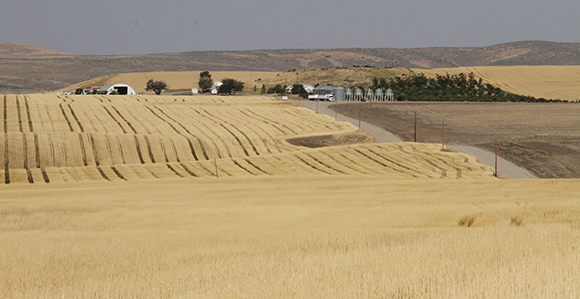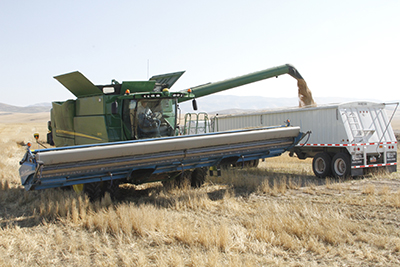Church’s Blue Creek Welfare Farm Helps Feed Thousands
Contributed By Jason Swensen, Church News staff writer

The rolling “amber waves of grain” on the Church’s Blue Creek Grain Farm in northern Utah.
Article Highlights
- The Church operates several welfare farms across the world, but Blue Creek might just be its crown jewel.
- It’s the largest of its kind and has been a reliable source of hard red winter wheat for the Church’s global welfare program.
- Most of the wheat will be milled into flour that will produce food to be stocked on the shelves of bishops’ storehouses across the world.
Related Links
BOX ELDER COUNTY, UTAH
There’s no evidence that lyricist Katharine Lee Bates ever saw the Church’s Blue Creek Grain Farm before she penned the lines “Oh, beautiful for spacious skies, for amber waves of grain” (“America the Beautiful,” Hymns, no. 338).
But if you visit the Church’s flagship wheat farm—located just a few miles south of the Idaho border in Utah’s Box Elder County—you’ll likely find yourself humming her beloved song.
The opening lyrics and the farm make a perfect fit. The skies here are indeed spacious and preside high above a gently shifting sea of ripe amber wheat. But the beauty of this sprawling 12,000-acre farm stretches beyond the pastoral. Most of the wheat harvested here each year will be used to feed hungry families and individuals.
It’s harvest time at wheat fields across the United States and Canada, but the Blue Creek Grain Farm is different than most others.
“This farm produces the wheat for commodities that will help people in need,” said Church welfare specialist Wade Sperry. “It’s an important part of the Church’s welfare system.”
The Church operates several welfare farms across the world, but Blue Creek might just be its crown jewel. It’s the largest of its kind and has been a reliable source of hard red winter wheat for the Church’s global welfare program for more than a half century.
Over the past several decades, the size and sophistication of Blue Creek’s tractors and storage bins have increased, but the growth cycle remains largely the same. Each fall, wheat seed is planted across half the farm. The second half is allowed to rest and will remain fallow for a year’s time.

Farm worker dumps wheat grown at the Blue Creek Grain Farm into the onsite storage bins. Photo by Jason Swensen.

A combine pours thousands of pounds of harvested wheat into the bed of a waiting truck. The grain is then hauled to onsite storage bins. Photo by Jason Swensen.

From left, farm manager Cary Sanders is joined by Area Seventy Elder Peter Evans and welfare employee Wade Sperry high atop the wheat storage bins that offer an expansive view of the Blue Creek Grain Farm. Photo by Jason Swensen.

Farm manager Cary Sanders takes a step inside an empty wheat storage bin. Photo by Jason Swensen.

A combine cuts and gathers ripe wheat at the Blue Creek Grain Farm in northern Utah. Photo by Jason Swensen.
Following the winter’s thaw, hundreds of volunteers converge on the farms and assume the Sisyphean task of removing rocks. Locals joke that Blue Creek’s rich soil yields first-rate wheat and endless numbers of rocks. Still, members of all ages do their best to clear the largest stones from the active wheat fields.
Later, farm workers will spray for bugs and weeds and then turn their attention to the skies. Blue Creek is a dry farm. There’s no irrigation here, so all the moisture that will water the thirsty wheat is literally a gift from heaven.
God is a full-fledged, day-to-day partner in the operation and success of this essential welfare farm.
“Remember, this area of the country is a desert,” said farm manager Cary Sanders as he eyed the arid hills bordering the wheat fields. “We are dependent upon the Lord and His mercy for this crop.”
Each year, neighboring stakes gather for organized fasts and humble prayers on behalf of the Blue Creek farm. Their invocations are simple: Let it rain.
Brother Sanders and other welfare workers are pleased with the ongoing 2014 wheat harvest at Blue Creek. Each active acre is producing between 40 to 60 bushels. (A bushel is roughly 62 pounds of wheat). That’s a respectable figure for Utah dry farming.
The harvest here lasts about three weeks. On a recent morning, Brother Sanders sat at the controls of a massive John Deere combine. Attached at the front was a 32-foot stripper that cuts the wheat and sends the precious grain into the combine’s rear storage bin.
The GPS-equipped combine does much of the steering, so Brother Sanders and the other workers are allowed moments of reverent reflection.
“You do have time to contemplate what this farm is all about,” he said.
After cutting through several acres, Brother Sanders dumps his harvested wheat into the massive bed of a waiting semi-tractor trailer. The wheat is then moved to five towering onsite storage bins, where it awaits eventual transfer to one of the Church’s welfare mills or permanent storage silos.
Ultimately, most of the wheat will be milled into flour that will produce millions of loaves of bread and boxes of pasta to be stocked on the shelves of bishops’ storehouses across the world.
A portion of the Blue Creek harvest, explained Brother Sperry, will also be used to replenish the Church’s permanent strategic storage bins located in 28 cities across the United States and one in Canada. The Church adheres to a mandate to store 9.1 million bushels of wheat at all times for use in times of famine or other emergencies.
“All of this,” he said, “is made possible because of the generosity of our members through their tithes and other offerings.”
